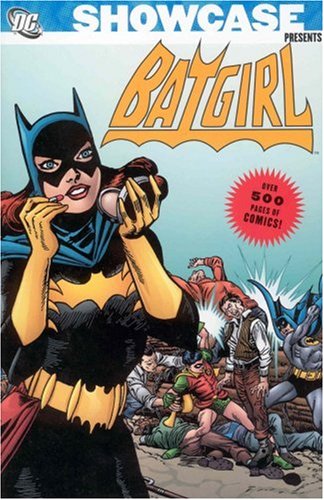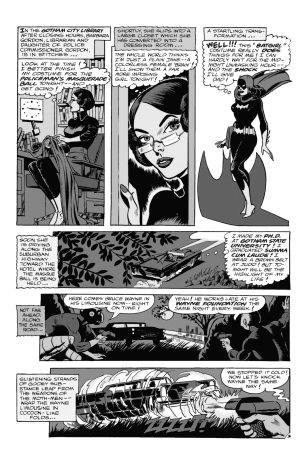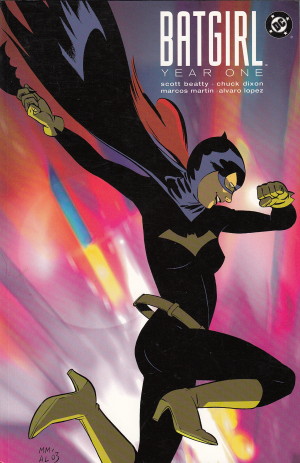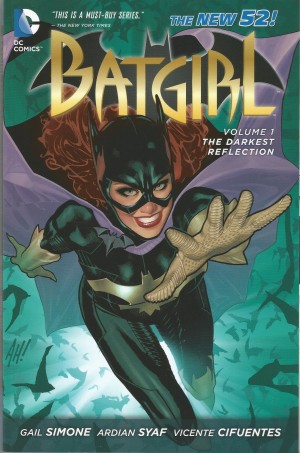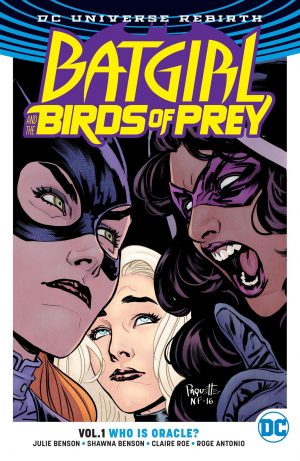Review by Win Wiacek
It’s largely forgotten that Batgirl’s early exploits were during an era where women in fiction were finally emerging from the marriage-obsessed, ankle-twisting, deferential, fainting hostage-fodder mode that had been their ignoble lot for untold decades. Her earliest comic appearances reflect the faltering steps.
1967 saw ‘The Million Dollar Debut of Batgirl’ by Gardner Fox and artist Carmine Infantino introducing young Barbara Gordon (sample art). She’s a mousy librarian and daughter of the Police Commissioner, but in costume pummels Killer Moth in a clever, fast-paced yarn involving blackmail and murder.
Her appearances came thick and fast after that initial tale, with Fox conceiving most over her first year. They’re challenges like deducing Batman’s secret identity in her second appearance, but all too often memorable for the wrong reason. There’s reinforced boyhood prejudices about icky girls in ‘Batgirl Breaks Up the Dynamic Duo’ and the frankly daft ‘Catwoman sets Her Claws for Batman!’ It’s mostly remembered for a classic cover of Batgirl and whip-wielding Catwoman squaring off over Batman’s prone body.
Artistically she’s better served with Infantino, Curt Swan drawing Cary Bates’ teaming with Supergirl, Mike Sekwosky when she guest stars with the Justice League, and the moody, hyper realistic renderings of Neal Adams on a second Supergirl teaming. In Gil Kane’s outing she’s referred to as “the Dominoed Daredoll” from page two onwards, and Fox proffers uncomfortable assertions about female vanity.
In 1969 Batgirl was awarded her own solo feature illustrated by the phenomenal team of Kane and Murphy Anderson. It’s an engaging run of human-scaled crime dramas with what Mike Friedrich then Frank Robbins clearly believed was a strong female slant, as seen in the first yarn wherein librarian Babs develops a crush on a frequent borrower just before he inexplicably vanishes. The nadir is ‘Batman’s Marriage Trap!’ wherein the unfulfilled spinsters of America are set on the trail of Gotham’s Most Eligible Bat-chelor. However, ridicule discounts Robbins producing viable crime sagas, a good example being ‘A Clue… Seven-Foot Tall!’, savvy and contemporary, introducing disabled Vietnam veteran and neophyte private eye Jason Bard. Here and in the concluding ‘Downfall of a Goliath’ Babs and Bard spar before joining forces to solve a brutal murder in the world of professional basketball.
One of the most compelling and clever tales of the entire run is Robbins’ wickedly clever ‘Battle of the Three “M’s”’ (that’s Mini, Midi and Maxi to you), as a trendsetting celebrity finds herself targeted by an unscrupulous designer, leading to a murderous deathtrap for Babs in ‘Cut… and Run!’ The vastly underrated Don Heck is now artist, always good on non-costumed scenes. Robbins and Heck also reveal a shocking secret about the Commissioner that simmers through the remaining adventures, beginning with ‘The Kingpin is Dead!’, concerning a “motiveless” hit on an old gang-boss all cleared up in spectacular fashion with ‘Long Live the Kingpin!’ The series takes a landmark turn in ‘The Unmasking of Batgirl’ as a charmer breaks her heart and Babs decides to chuck it all in and run for Congress in ‘Candidate For Danger!’
That’s not quite the end as in 1973 and 1975 Elliot S. Maggin and Swan team her with Superman and Supergirl respectively.
While very much a product of their misguided era, these tales are drenched in charm and wit; drawn with a gloriously captivating style and panache that still delights and enthrals. This content is also available in the full colour hardcover Batgirl: The Bronze Age Omnibus.
